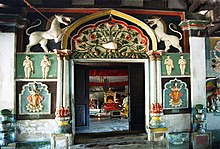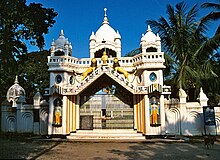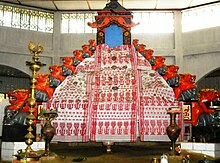Satra (Ekasarana Dharma)



Satra are institutional centers associated with the Ekasarana tradition of Vaishnavism, largely found in the Indian state of Assam and neighboring regions.[1][2] Numbering in the hundreds, these centers are generally independent of each other and under the control of individual adhikara (or satradhikar), though they can be grouped into four different Sanghati (orders).
These centers, in the minimum, maintain a prayer house (Namghar, or Kirtan-ghar), initiate lay people into the Ekasarana tradition and include them as disciples of the satra from whom taxes and other religious duties are extracted. The Neo-Vaishnavite satra culture started in the 16th century. They grew rapidly in the 17th century and patronage extended to them by first the Koch kingdom and later the Ahom kingdom was crucial in the spread of the Ekasarana religion.[3] Many of the larger Satras house hundreds of celibate and non-celibate bhakat (monks), hold vast lands and are repositories of religious and cultural relics and artifacts. The satra extend control over their lay disciples via village namghar. Satra in which the principal preceptors lived, or which preserve some of their relics are also called thaan.[4]
Another satra was established by king Samudrapal at a place known as Yogihati in the same period (1232 CE) as evident from a stone inscription found in Ambari.[5] The neo-Vaishnavite satras were established by Assamese Vaishnavite monasteries for religious practices at the initiative of the Ahom Kings of Assam in the middle of the 17th century[web 1] to propagate neo Vaishnavism.[web 2][web 3] Sankaradeva is said to have established his first Satra at Bordowa, his birthplace, and then in different places of Assam.[web 4][web 5][6]
Through initially the satras were started as a part of the egalitarian movement of Eksarana Dharma, they later turned into a place of orthodoxy. From the early 20th century, the authority and orthodoxy of the Satras have been challenged by reform movements, most notably under the Sankar Sangha. The Satras coordinate some of their activities via the Asam Satra Mahasabha, an umbrella organization of all the Satras. According to the Mahasabha's count on its website there is altogether a total of 862 Satras including the satras present in both the states of Assam and West Bengal.[web 6]
Structures
[edit]
The Satra is generally a four-sided enclosed area with four gateways (karapat). Centrally placed in this enclosure is a rectangular prayer-hall (Namghar or kirtanghar) at the aligned in the east–west direction. On its eastern side there is an additional independent structure called the Manikut (jewel-house), the sanctum santorum, in which the asana (a wooden tetradehral structure with four carved lions) is placed containing the main object of worship (usually a copy of the Bhagavat Purana in manuscript or an idol). The namghar is surrounded by four straight rows of huts, called hati, in which monks (bhakats) reside. The adhikara and other high officers of the Satra reside in the eastern hatis.[7]
All structures were originally temporary, made with wood, bamboo and covered over with thatch; brick and mortar found use after the 18th century.[8] Monks, called bhakats, live in satras under a satradhikar or Mahanta. In some orders of the religion, the bhakats are celibate (kewalia bhakat). The satradhikar may not always be of high birth, it is recorded in many instance the satradikars belonging to tribal or lower caste origin. For example, Mathuradasa Ata, the first satradhikar of Barpeta was from the Candal community, Narayanadasa Ata, a disciple of Sankardev was from the weaver community (Tanti) similarly Sesa, Katani, Budhbari, Chahila satras were held by Kaibartas although they claim to be of Kayastha origin.[9] The satras are not merely religious institutions but play cultural and historical roles in society. A dance form that was initiated by Srimanta Sankardeva and later developed within the sattras, and thus called Sattriya, is one of the eight classical dance forms in India.
Origin and evolution
[edit]The name satra originates in the Bhagavata Purana in Sanskrit (sattra), and is used in the sense of an assembly of devotees.[10] During Sankardev's lifetime, the devotees assembled in the open, under trees. Though temporary prayer houses were built, the tradition of devotees living in the premises did not happen during Sankardev's lifetime. The first mention of the hati is found in the context of the Patbausi Satra of Damodardev. Madhavdev built the Barpeta Satra, and laid down the system of daily prayer service and initiated the system of religious tithes. Vamsigopaldev was instrumental in establishing Satras in eastern Assam.
The last quarter of the 16th century saw the satras divide into four different sects (also called samhati)—Brahmasamhati, Purusasamhati, Nikasamhati, Kalasamhati. These four sects were firmly established by the early 17th century.

Damodaradeva (a Brahmin disciple of Sankardev) formed the Brahmasamhati, which represented the Brahmanical practices and ritualism. It brought back the caste system to its original form but still adhered to the teachings of namadharma of Sankardev.[11] The followers of this sect called themselves Damodariyas (meaning: followers of Damodaradeva) and the satradhikar was chosen from a Brahmin family.[12] It had close relationship with the Koches and the Koch king Nara Narayan was initiated into the Vaishnava order by Damodaradeva.[13] Auniati satra, Dakhinpat Satra, Garamur satra and Kurawabahi satra became the most influential of the Brahmasamhati and received royal patronage from the Ahom kings.[14]
Caturbhuja Thakur, one of the grandson of Sankardev headed the Purusasamhati. This samhati practiced the original features of Sankardev teachings and therefore considered to be the main sect. The head priest was chosen either from a Kayastha or a Brahmin family.[15] The term purusa is claimed to be derived from the honorific title Mahapurusa, usually applied to Sankardev.[16] Bardowa satra founded by Sankardev remained the most popular satra of the Purusasamhati.[17]
The next samhati, the Nikasamhati was established by Mathuradasa and Padma Ata, both of whom were disciples of Madhavdeva. It strictly conformed to the teaching of Madhavdeva and being a purist group placed more important on ascentism,[18] Kamalabari Satra, Barpeta Satra and Madhupur Satra are the three centers of this samhati. The last of the samhati, the Kalasamhati concerned with the tribal and lowercaste societies,[19] represented the offshoots of six sudra satra and six brahmana satra formed by Gopala Ata and his followers during the late 16th and early 17th centuries.[20] The Mayamara satra and Dihing Satra, the two most important of the sudra satras admitted various local tribes into its fold — Kacharis, Kaibartas, Chutiyas, Morans, Ahoms etc.[21] The Mayamara satra formed by Aniruddhadev (a disciple of Gopala Ata) later became the most prominent among the six sudra satra of the Kalasamhati and revolted against Ahom kingdom during the latter part of the 18th century.[22]
The first three samhati —Brahmasamhati, Purusasamhati, Nikasamhati brought back the caste rules and Brahmanical rituals, while the Kalasamhati rejected caste rules and idol worship in its entirety.[23]
The Ahom kingdom initially resisted the ingress of religious preceptors it finally endorsed the Satras, enabling them to establish themselves on sound economics, make themselves attractive to the lay people, and spread the Ekasarana religion. The 17th century saw the rapid growth of the Eksarana Dharma in upper Assam[24] and Majuli became a focal point of Satra tradition and authority. The number of Satras grew during this period, 125 Satras built in the 17th century and 85 Satras built in the 18th century, while suffering two major setbacks — Moamoria rebellion and Burmese invasion of Assam.[25]
Cultural programmes
[edit]Some of the cultural programmes, which are held in Sattras:
- Bhaona
- Doul Utsav or Deul
- Janmastami
- Rasa lila or Raas utsav
See also
[edit]Notes
[edit]- ^ (Dubey 1978, pp. 189–193)
- ^ Sarma 1966.
- ^ (Sarma 1966, pp. 23–24)
- ^ (Sarma 1966, p. 101)
- ^ "The inscription has recorded that Samudrapala who was like the Sun God had this sattra establishment within his jurisdiction, in which rituals were performed and was attached to the royal residence, the inmates of the sattra being the yogis or siddhas, residing at a particular spot called YogihatT. The inscription is dated Saka 1154 (A.D. 1232) and was composed by one Mudha." (PDF). Archived (PDF) from the original on 11 June 2020. Retrieved 25 May 2020.
- ^ (Chakravarty 1989, p. 4)
- ^ (Neog 1980, p. 309)
- ^ (Neog 1980, p. 313)
- ^ "Dihial Goswami forefather was Kairbatta although he claims to be Kayastha. The first satradhikar of Barpeta was Mathuradasa Ata from a Candal community (schedule caste). Next was Naranayanadasa Ata who was a weaver. The Puranimati satradhikar was originally a Maran (tribal), now called Kayastha. Sesa, Katani, Budhbari and Chaliha satras have Kaibartta adhikars who are called Kayastha today"(Sharma 2009:359)
- ^ Neog (1980), p. 310
- ^ Shin (2017, p. 248): "This sect admitted brahmanical rites together with general devotional practices and took a rigid view of caste distinction"
- ^ Shin (2017), p. 248
- ^ Shin (2017, p. 248): "They had a close relation with the royal family of the Koches. The Koch king Naranaraya was initiated into the Vaishnava order by Damodaradeva."
- ^ Shin (2017), p. 248
- ^ Shin (2017), p. 248.
- ^ Shin (2017), p. 248
- ^ Shin (2017, p. 248): "The Bardowa satra constructed at the birthplace of Sarkaradeva is the most well-known institution of the Purusasamhati"
- ^ Shin (2017, p. 248): "(T)his branch, which strictly conformed to the teaching of Madhavadeva, and this sect came to be known as the Nikasamhati"
- ^ Nath (2014), p. 353
- ^ Shin (2017), p. 248
- ^ Shin (2017), p. 249
- ^ Shin (2017, p. 249): "(T)he Mayamara satra of Aniruddha has rapidly emerged as a great adversary of brahmanas and revolted against the Ahoms in the latter part of the 18th century"
- ^ Nath (2014, p. 353): "While the three samhatis - brahma, purusha and nika adhered to caste rules and introduced Brahmanical ritualism in greater or lesser amount, the kalasamhati defied caste-rule in totality, rejected idol worship, and adhered to the nirgun form of bhakti"
- ^ Shin (2017, p. 243): "(T)he 17th century onwards, when the movement expanded to the upper Brahmaputra Valley, the area under the rule of the Ahom kings"
- ^ Shin (2017), p. 243
References
[edit]Published-sources
[edit]- Dubey, S. M. (1978). North East India: A Sociological Study. Concept. pp. 189–193. Archived from the original on 3 January 2020. Retrieved 13 October 2016.
- Nath, S N (2012). SATRA SOCIETY AND CULTURE, Pitambardeva Goswami and History of Garamur Satra. DVS Publisher. ISBN 978-81-86307-56-4. Archived from the original on 17 October 2013.
- Neog, Maheshwar (1980). Early History of the Vaishnava Faith and Movement in Assam. Delhi: Motilal Banarasidass.
- Sarma, S N (1966). The Neo-Vaisnavite Movement and the Satra Institution of Assam. Gauhati University. ISBN 978-8173310263.
- Shin, Jae-Eun (2017), "Transition of Satra from a Venue of Bhakti Movement to the Orthodox Brahmanical Institution", in Ota, Nobuhiro (ed.), Clustering and Connections in Pre-Modern South Asian Society, Tokyo: Tokyo University of Foreign Studies, pp. 237–257
- Nath, Dambarudhar (2014), "Cult, ideology and conflict: The "MĀYĀMARĀ" Vaishnavism and social conflict in 18th century Assam", Proceedings of the Indian History Congress, 75: 351–357, ISSN 2249-1937, JSTOR 44158402
- Chakravarty, Archana (1989). History of Education in Assam. Mittal Publications.
- Sharma, Chandan Kumar (2009). "Tribe Caste Continuum and the Formation of Assamese Identity". In Medhi, B.K (ed.). Tribes of North-East India: Issues and Challenges. Delhi: Omsons Publications. pp. 354–366.
Internet
[edit]- ^ "Sri Sri Auniati Satra:". Auniati.org. Archived from the original on 2 June 2015. Retrieved 28 March 2013.
- ^ "SATRA". Vedanti.com. Archived from the original on 4 March 2016. Retrieved 28 March 2013.
- ^ "Satras". OnlineSivasagar.com. Archived from the original on 29 December 2014. Retrieved 28 March 2013.
- ^ "The Sentinel". Sentinelassam.com. Archived from the original on 24 September 2015. Retrieved 28 March 2013.
- ^ "Temples & Legends Of Assam.Satras-III". Hindubooks.org. p. 1. Archived from the original on 27 December 2014. Retrieved 28 March 2013.
- ^ Correspondent (12 October 2009). "Satra Mahasabha renews demand for separate directorate". The Assam Tribune. Archived from the original on 7 May 2013. Retrieved 7 May 2013.
{{cite news}}:|author=has generic name (help)
External links
[edit]- A view of a Satra in Majuli, Assam, India on YouTube
- A Tribute to Sankaradeva—A website on the Neo-Vaisnavite Movement of Srimanta Sankardeva
- Bhakti Movement in the Brahmaputra Valley: Response of the Satra Institution towards Social Equality
